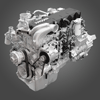
Paccar, Bellevue, Wash., last month introduced the Paccar MX engine to be installed in heavy-duty North American Kenworth and Peterbilt trucks beginning this summer, and I had the opportunity to participate in the event.
Paccar is a global technology leader in the design, manufacture and customer support of high-quality light-, medium- and heavy-duty trucks under the Kenworth, Peterbilt and DAF (a leading commercial vehicle manufacturer in Europe) nameplates.
The new engine, developed through a very significant investment in research and testing, has been designed to deliver industry-leading performance, durability, reliability, fuel efficiency and low cost of ownership. It is the latest evolution of Paccar’s strategy to create its own powertrain.
The Paccar MX is available with a horsepower (hp) range of 380 to 485 hp and torque outputs from 1,450 to 1,750 pound-feet. It will work with all types of transmissions.
The engine is designed to meet the U.S. Environmental Protection Agency’s 2010 emissions regulations and has accumulated more than 50 million test miles in rigorous and severe conditions in North America, says Jim Cardillo, Paccar’s president. EPA certification is expected soon.
The Paccar MX engine uses selective catalytic reduction (SCR) in combination with exhaust gas recirculation to meet the emissions regulations. For the SCR catalyst, it is using copper zeolite. It is more efficient in reducing diesel engine emissions compared to the iron zeolite commonly used, says Craig Brewster, Paccar’s assistant vice president.
A lightweight six-cylinder engine, the Paccar MX uses four valves per cylinder and an in-block cam design with displacement of 12.9 liters. Incorporated into the engine are a number of advanced design and component integration features that give it improved reliability, durability and serviceability for reduced downtime.
The Paccar MX has a B10 engine life of one million miles, meaning 90 percent of the engines will reach that mileage. “That is unparalleled,” says Alan Treasure, Paccar’s director of marketing. Other engine manufacturers’ stated durability is B50 — 50 percent of the engines will reach one million miles.
“Paccar pioneered the design and manufacture of high-strength compacted graphite iron used in the MX engine block and cylinder head,” he says. “This premium material is stronger (75 percent) and lighter (20 percent) than conventional grey iron, resulting in superior power-to-weight performance.”
In addition, there is a single camshaft with no counterweight — a more simplified, 25-pound lighter design. “This reduces weight and increases power for quicker acceleration and smoother overall operation,” Treasure says.
The Paccar MX uses fractured cap technology for connecting rods and main bearing caps. This technology produces a rough irregular mating surface that forms when the bearing cap is physically fractured from the rod, virtually eliminating cap shift. This results in greater strength and contributes to longer power and torque curves along a wide revolutions per minute (rpm) range.
The engine’s block design, rear geartrain and floating oil pan significantly contribute to reduced vibration and lower in-cab noise levels for a more comfortable driver environment, notes Ben VanderGriend, Paccar’s director of engineering. The Paccar MX is two to three times quieter at idle and 1.5 times quieter at 55 to 70 miles per hour than competitive engines.
I had a chance to drive a variety of Kenworth and Peterbilt tractors with the new engine with different horsepower ratings pulling fully loaded trailers. I was pleasantly surprised with the responsive feel, power and quietness — both inside and outside. Once in top gear, I seldom had to downshift.
An integral engine compression brake provides best-in-class 460 brake hp at 2,200 rpm, Treasure says. “That is 15 more brake horsepower than the nearest competitor.”
The electrical systems for the Paccar MX engine provide increased reliability through the use of sealed connectors and an air-cooled electronic control module. A fully encapsulated wiring harness mounted directly to the block protects wiring from the elements and removes stress from connectors for a more dependable electrical system.
The new engines have a comprehensive two-year or 250,000-mile standard warranty, with many extended protection plans available, says Kurt Freitag, Paccar’s director of aftermarket. Highway trucks have extended protection plans for up to five years or 500,000 miles.
All Kenworth and Peterbilt dealers have been certified to work on the new engines and have made the necessary investments in tools and equipment, parts and training, he says. More than 1,000 technicians already have completed the training, and more are going through the process.
In addition, Paccar has updated its Engine Rapido (electronic parts and service catalog) and diagnosis analysis for vehicle interface equipment service (Davies) systems with information on the Paccar MX engines, Freitag says. These electronic libraries, which are updated regularly, give technicians instant access to detailed information about specific trucks, service manuals and diagnostic guidelines, helping repairs get done quickly and accurately.
The Paccar MX will be built at a new $400 million, 400,000-square-foot Paccar engine plant in Columbus, Miss. Initially, the plant will reconfigure Paccar MX engines built in Europe for North American truck production. Later this year, the plant will begin full assembly of the engines.
While new to the North American market, more than 125,000 Paccar MX engines are operating successfully in DAF Trucks globally.
Paccar now has a full family of engines: Paccar 4.5 liter (Europe), PX-6 6.7 liter, PX-8 8.3 liter, PR 9.2 liter (Europe) and new PX 12.9 liter, and its own axles. It is now eyeing development of its own gearboxes and transmissions.
About 10 years ago, Paccar developed a strategy to offer a complete Paccar powertrain, says Mark Pigott, company chairman and chief executive officer, and “this is a very important goal for us.”
During the past decade, Paccar has invested more than $1 billion in capital and research and development in creating its own powertrains. The design objective is to have the lowest cost of ownership, he says, and that comes from creating best-in-class durability and reliability, fuel economy, drivability, torque-to-weigh ratio and serviceability.BI
Related Links:
Nov. 2009 Distribution: 2010 Truck Roundup